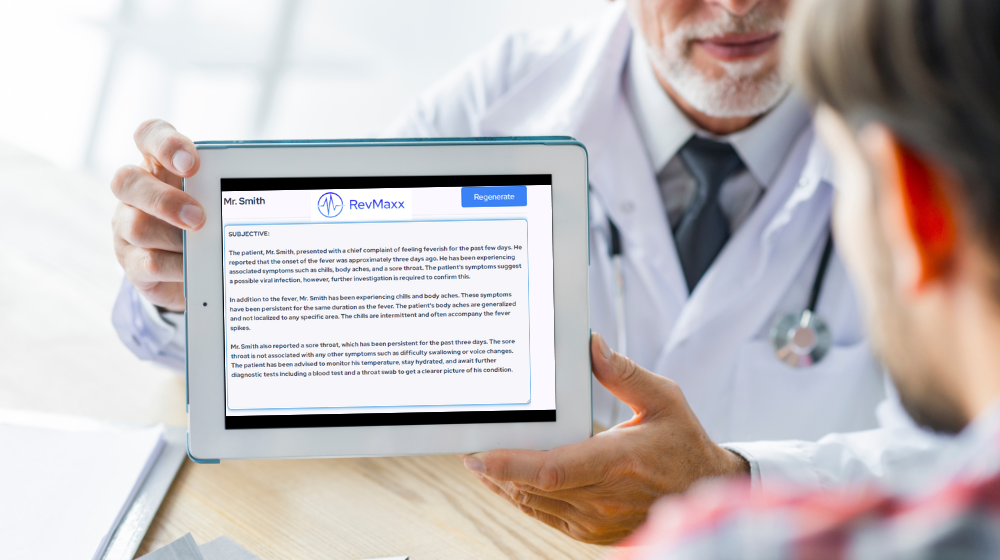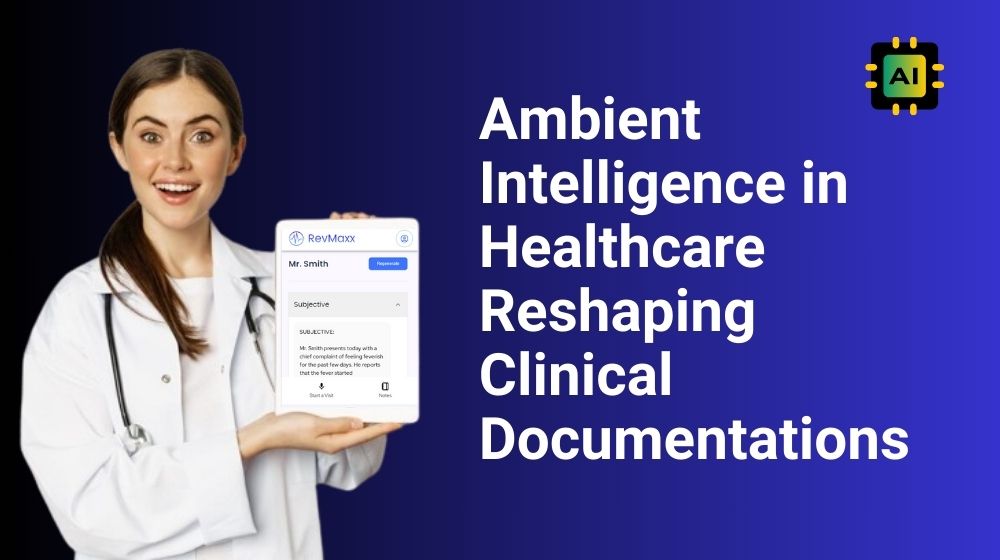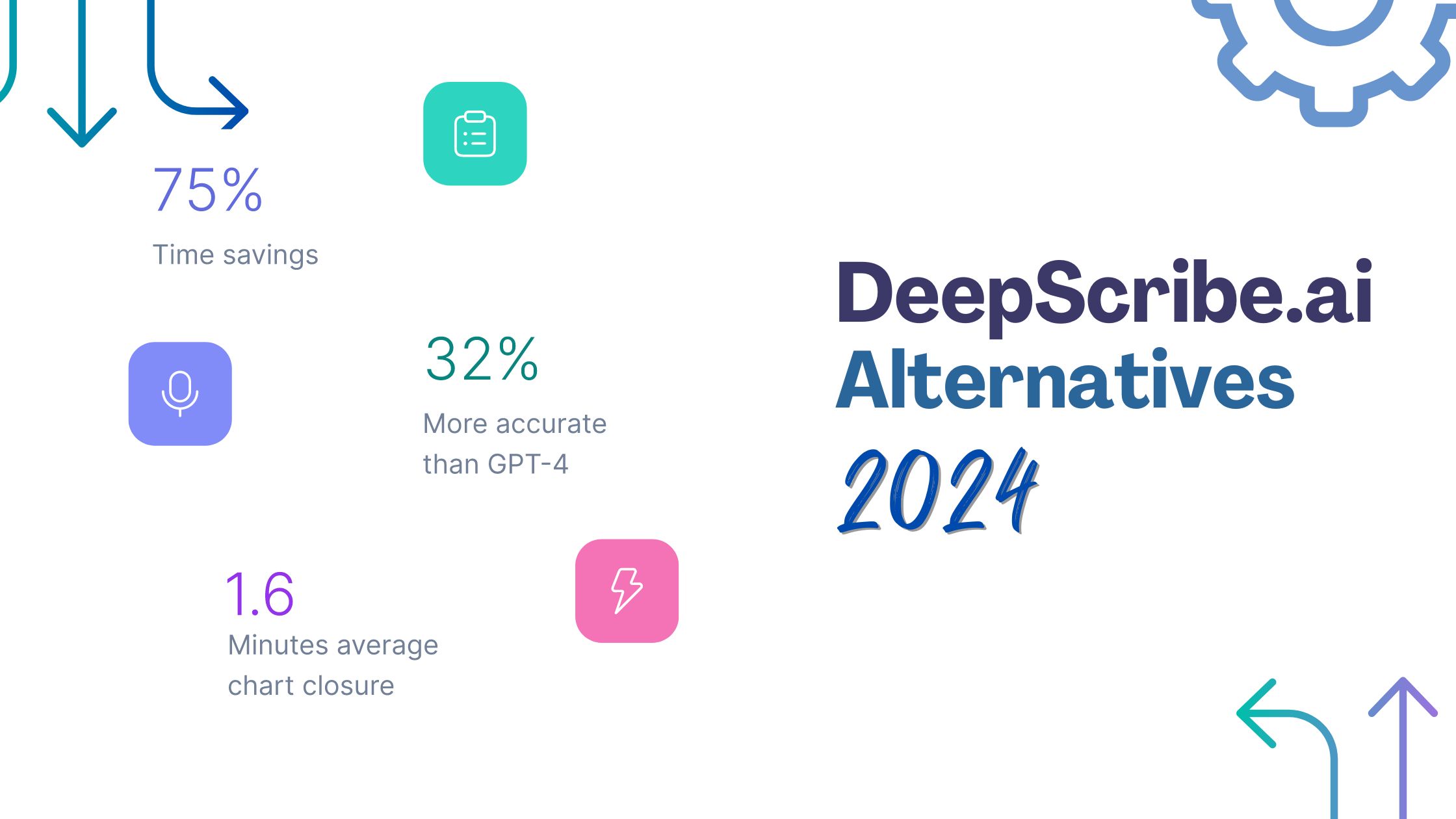Introduction
While researching this topic, we went through a lot of data-driven surveys and peer-reviewed research. Yet, one personal blog by a physician struck our eyes the most.
Rebekah Bernard MD, in her blog, writes:-
“After stumbling upon rave reviews for an AI documentation system in one of my social media medical groups, I logged in for a free 10-note trial. By the 9th patient visit, I was grabbing my credit card to sign up. I’m also hearing from many of my colleagues who are ecstatic about how AI has helped improve their quality of life.”
The role of AI Scribe medical software in accurate medical transcription contributes significantly to the data-driven world of healthcare. So, it is not surprising that AI scribe devices are the talk of the medical hour, as more doctors open up to Artificial intelligence in healthcare.
A Deep Dive Into Data
We are looking at data from two points of view:
- A specialized approach
- A generalized approach
Special Use Cases of AI Scribe Medical Software
- In October 2023, The Permanente Medical Group (TPMG) enabled ambient AI technology for 10,000 physicians and staff for 10 weeks, during which 968 physicians used the tool more than 100 times.
- JAMA Internal Medicine reported how physicians saw a great reduction in time spent on EHR documentation, “both during clinics and after hours.”.
- University of Michigan Health West (UMHW) saw such a massive drop in physician burnout after implementing AI scribe software, that it is “comparable to a clinician going from full-time work to part-time work. “
General Studies on AI Scribe Medical Uses
- About 75% of US hospitals are already using AI in healthcare to process medical data. - specifically for data organization, structuring, and analysis.
- According to a survey by Elation Health, 33% of primary care physicians have already tried AI scribe tools.
- After implementation, recent surveys reveal that physicians spend around 20.7% of their time inputting EHR data and approximately 66.5% of their time directly engaging with patients.
- Physicians also anticipate benefits to the clinician care experience with 83% expecting higher quality clinical note taking, 81% expecting reduced physician burnout and 89% hoping for improved job satisfaction.
What Am I Signing Up For?
Recognizing the plight of physician burnout after spending hours behind non-clinical tasks and documentation, artificial Intelligence in healthcare utilizes the power of cutting-edge algorithms to free physicians of such obligations.
Documentation is a significant task for doctors, but is the 4 hours of non-clinical burnout worth it?
AI’s use of technologies like automatic speech recognition and processing and machine learning algorithms to organize them is perfect for capturing spontaneous dialogue between doctors and patients. Hence, you can spot an AI scribe software implemented in the most advanced clinical settings, working in telehealth visits, and inpatient appointments.
Benefits that Make AI Scribes Popular
Productivity ROI: Physician Burnout Reduction
“The holy grail in medicine right now is improving burnout while also maintaining or improving productivity and quality,” says Patricia Garcia, MD, a clinical officer at Stanford Health Care
The primary idea behind building an AI Scribe software technology is to save doctors and other clinicians time on administrative tasks so they can put all of their energy into patient care. This entails a MASSIVE reduction of physician burnout –
Physicians paired with an AI scribe saw a 27% decrease in physician burnout and reclaimed up to 66 minutes for every 8 hours of work, indicating significant time savings that can be redirected towards patient care or other critical tasks

Financial ROI: A Smoother, Faster Revenue Cycle for the Physician
- AI Scribe medical software can facilitate a higher patient flow in clinics. Providers can treat more patients in a day by investing less time in paperwork, which increases clinic income.
- To further improve a clinic’s business line, physicians might devote more time to treating complicated cases and carrying out higher-paying operations.
By reducing medical coding errors by 42%, physicians have the utmost assurance that the appropriate billing codes are assigned to each service, thereby leading to faster reimbursement. Along with error reduction, AI Scribes increased revenue 2x.
- Operational Efficiency
- Regulatory Adherence
- Revenue Maximization
Clinical ROI - Enhanced Patient Care
AI Scribe medical software can facilitate increased patient-provider facetime.
Providers spend less time on clinical notes, spending more time and energy engaging with patients For example, introducing AI Scribe medical software at Cooper Healthcare has resulted in doctors devoting 43% less time to working on documentation and other non-clinical tasks.
This increased Facetime can lead to a deeper understanding of a patient’s needs and preferences, enabling providers to deliver more tailored and effective treatment plans.
How AI Scribe Medical Software Works
The use case of any typical AI Scribe software involves:
- At the beginning of the patient visit, the physician must tap an icon on the app to begin recording.
- They can end the recording by pressing the icon once more after the visit.
- The AI Scribe medical software software can examine the AI-generated records right away.
What Physicians Think Of Features of AI Scribe medical software
Technology
AI Scribe software technology is heralded by three main factors:
- Accuracy
- Speed
- Hybridity
On Accuracy
The problem:
In the healthcare world, accuracy is a big issue.
The American Medical Association (AMA) estimates that coding errors cost the healthcare sector over $36 billion annually. These errors can lead to possible fines, rejected claims, and lost income.
So, when it comes to AI in clinical notes, according to the survey of 229 primary care physicians, doctors report a lack of confidence in accuracy and a lack of integration or access through existing tools, along with no time to research options, as key obstacles to adoption,
The solution:-
Speaking of accuracy, an AI medical record startup called DeepScribe reported that human reviewers increased the AI’s accuracy by 15 percentage points to 95%.
Accuracy is further promised by the following studies:-
- Research has shown that AI-based solutions can exceed 99% accuracy, with AI Scribe software like RevMaxx adapting and refining their coding capabilities based on feedback and real-world data, ensuring the accuracy and reliability of the generated codes. This adaptive learning approach enhances the coding process, resulting in more precise and consistent coding outcomes compared to an individual scribe accuracy ranging from 50% to 76% only.
- Integration of AI documentation has made clinical notes much more structured – as opposed to handwritten notes made by the doctor himself. AI Medical Documentation has helped overcome medical errors like illegible handwriting, reducing the number of error-led deaths, as reported by the Institute of Medicine’s “To Err is Human” report.
- This artificial intelligence in healthcare implements technology that enables AI scribe medical devices to be trained on massive datasets containing a wide variety of speech patterns, accents, and dialects from different regions and languages
On Speed
The problem:-
A survey by Wakefield Research in 2021 reported shocking results. Of the staff surveyed:
- 89% of doctors stated they are required to verify multiple databases to get patient data,
- Hospital staff members claimed that their amount of manual data input had grown by 50%.
- According to 36% of physicians, handling administrative tasks takes up more than half of their day.
Solution:-
Reduction in delay in Documentation
Manual coding requires longer hours as medical coders must navigate a lot of clinical notes to locate the information they need. This procedure can be automated by AI medical coding software, freeing up coders’ time to work on more difficult situations.
Voice-enabled AI Scribe software like RevMaxx AI and Tali are up to three times faster than manually keying in patient notes, showcasing the speed at which AI scribes can work.
Natural language processing (NLP) algorithms scanning electronic health records not only increase the speed and accuracy of the process but also allow for the utilization of larger and more complex data sets, improving the performance of AI models.
Reduction of delay in patient care
These coding and transcription errors aggravate patient experience. Delays in patient care, anxiety due to miscommunication, and the stress of dealing with medical errors can negatively impact patient satisfaction and their overall experience with the healthcare system.
With the reduction of medical errors with AI-promised accuracy and seamless integration, patient care has reached speedy solutions as physicians can complete daily checkups much more effortlessly.
Enhanced speed in billing procedure
Billing mistakes brought on by lacking or inaccurate paperwork may result in underpayments, rejected claims, and even possible fines and penalties.
Increased speed and accuracy in AI clinical notes can guarantee that clinics are invoicing for all of the services they render, leading to quicker payments from payers such as insurance companies.

On Hybridity of Workflow
As noted by our previous article, AI Scribe software in the current market follows two kinds of workflow methods:-
Human-in-the-loop (HITL) refers to an autonomous system that relies on human input, whereas
Human-out-of-the Loop (HOOL) is a system that does not rely on human input at all.
More versatile Medical Scribe software like RevMaxx AI offers hybridity (HITL) over complete AI autonomy. Solutions that are reviewed by real, trained scribes must always precede submission to EHR. This combines the sentient analysis by humans coupled with cutting precision offered by AI. Quick conversion of audio recordings into notes and error checking combined with medical expertise and a human touch, all contribute to overcoming the biggest barrier to technology: trust.
On Security: A human-led training team is mandatory to ensure AI systems are continuously updated to align with the latest regulatory standards. Teams must train the healthcare staff with sessions for system updates as per changing regulations.
“It’s important for leaders to provide training and awareness when it comes to responsible AI use. …..emphasizing the need for human review and verification.”
-Joe Atkinson, chief products and technology officer at consulting firm PwC.
Integration
With the increasing adoption of electronic health records and the growing demand for healthcare services, AI Scribe medical software is expected to witness continued expansion, offering substantial benefits to healthcare providers, insurers, and patients alike.
To substantiate at what rate EHR technology is growing today, the U.S. electronic health records market is projected to grow to 10.96 billion by 2032, at a CAGR of 4.70% between 2023 and 2032.
This growing adoption of electronic health records platforms among clinics, hospitals and diagnostic labs will significantly drive the global market during this era of rising innovation.
The Problem – Why Integration is Hard?
Physicians implementing EHR technology may encounter many interoperability challenges, such as the absence of standardized data formats, coding systems, and terminologies. Hospitals therefore wind up using incompatible software that does not effectively interface with their EHR, resulting in translation and documentation errors as well as loss of data.
The solution:-
Today, studies reveal how AI scribes are specially made to integrate with hospitals’ EHRs. Promising AI Scribe software like RevMaxx guarantees this depth of integration by supporting the following factors:-
- Retrieval of relevant data from the EHR, including physician schedules and appointment details.
- Pulling up and editing earlier clinical notes to record care across several, extended visits.
- Pushing clinical notes into the EHR and ensuring that they are appropriately stored there, including how they are organized into note sections and structured data elements like flowsheets.
- Using an AI assistant can result in a 40% reduction in after-hours work, including overnight work, and a 72% reduction in clinical note-taking time.
Security and Privacy
Emerging technology has struggled with one particular thing: Complying with laws governing patient privacy.
Especially in healthcare, where laws and regulations play a vital role in safeguarding patient privacy, AI Scribe medical software is equipped to ensure data security and promote ethical practices in the healthcare industry.
How?
- To guarantee compliance and reduce potential risks, medical coding AI incorporates healthcare legislation, such as the Health Insurance Portability and Accountability Act (HIPAA).
- Medical coding AI reduces the possibility of human coding errors and interpretive bias, which can result in coding irregularities or breaches of coding norms, by utilizing artificial intelligence technologies such as natural language processing (NLP). Additionally, the computerized approach lessens the possibility of unexpected mistakes or inappropriate patient data management.
- Furthermore, built-in compliance checks that support adherence to legal standards like HIPAA’s privacy and security guidelines may be included in medical coding AI. To maintain patient privacy and confidentiality, these algorithms can recognise and eliminate any personally identifiable information.
That being said, physicians are still worried about the possible risks of data sharing which comes with using a lot of the market’s AI technology. This is why AI Scribes like RevMaxx guarantee with proof that it will never sell your private information or divulge it to other third parties. Read more about RevMaxx’s compliance with privacy here.
Cost and Pricing
Apart from the reduction of physician burnout, one of the other primary advantages of implementing AI Scribe medical software is how massively cost-saving it is.
How?
- They are typically much less expensive to hire than professionally demanding human scribes in this climate of competitiveness among medical aspirants.
- By taking over these time-consuming responsibilities, AI Scribe medical software can reduce the need for additional staff members, such as transcriptionists and medical assistants, who would typically be responsible for handling these tasks.
- Medical scribe AI’s 24/7 constant availability has physicians prefer AI implementation far more than constant risks of staff shortages, turnarounds, and incompetence of manual coding.
AI Scribe medical software comes with various price structures. Physicians sign up for a pricing plan that suits best for them. As you assess various AI Scribe vendors, here are the most common pricing models for AI Scribe medical software in the market:-
- Price Structure:
- Subscription-based, such as per user per month
- Usage-dependent, such as per recorded session
- Separate rates are set for different user types (e.g., physicians vs. advanced practice providers)
- Price Amount:
- Actual cost of using the service
- Possibilities of fluctuation based on the number of users/ volume of transcription sessions
- Contract Terms:
- contract’s duration
- minimum commitment required by the vendors
- opportunity to scale up or down based on your evolving needs without penalty
Final Thoughts
The overall consensus on using AI Medical Scribes is positive. As AI slowly seeps into healthcare’s core duties, a digital scribe takes the role of a personal assistant to every physician out there who signed up for this new age of innovation. Such a commitment becomes 2x easier with cutting-edge AI scribe medical devices like RevMaxx coming to the forefront. One thing is clear:
With Artificial Intelligence in healthcare as a living breathing reality, the future of patient care looks brighter, guided by the new era of innovation and technology.









1 Comment
“Thanks for sharing this! I found your tips really helpful. Your explanations were easy to follow, and I appreciated how you broke down complex ideas into simple steps. I’m excited to try out some of these techniques on my own projects. Keep the posts coming!” Very good talent, keep it up!!